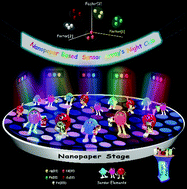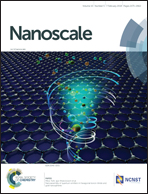A nanopaper-based artificial tongue: a ratiometric fluorescent sensor array on bacterial nanocellulose for chemical discrimination applications†
Abstract
In the present study, a ratiometric fluorescent sensor array as an artificial tongue has been developed on a nanopaper platform for chemical discrimination applications. The bacterial cellulose (BC) nanopaper was utilized for the first time as a novel, flexible, and transparent substrate in the optical sensor arrays for developing high-performance artificial tongues. To fabricate this platform, the hydrophobic walls on the BC nanopaper substrates were successfully created using a laser printing technology. In addition, we have used the interesting photoluminescence (PL) properties of an immobilized ratiometric probe (carbon dot-Rhodamine B (CD-RhB) nanohybrids) on the nanopaper platform to improve the visual discrimination analysis. Heavy metal ions were utilized as model analytes to verify the applicability of the fabricated nanopaper-based ratiometric fluorescent sensor array (NRFSA). Using the color variation of the NRFSA platform upon the addition of heavy metal ions, which have been obtained by a smartphone (under an UV irradiation), five heavy metal ions (i.e., Hg(II), Pb(II), Cd(II), Fe(III), and Cu(II)) have been well-distinguished through the RGB analysis via production of the characteristic PL fingerprint-like response patterns for each of them. Moreover, the developed optical sensor array was successfully exploited to identify the heavy metal ions in the water and fish samples. We have also found that the PL spectra, which have been obtained by a spectrofluorometer, of the developed NRFSA can be exploited for discrimination applications. We believe that the nanopaper-based artificial tongues will provide innovative insights into the development of optical sensor arrays towards advanced (bio)chemical discrimination applications and can revolutionize the conventional optical sensor array technology.



 Please wait while we load your content...
Please wait while we load your content...